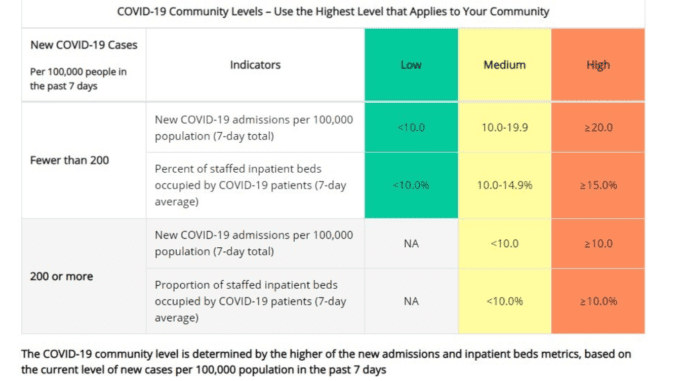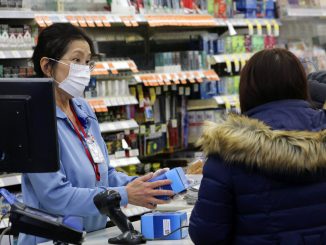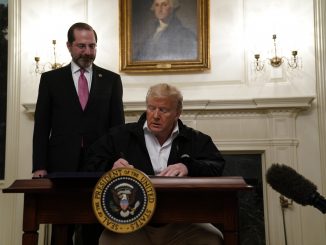
RALEIGH — The U.S. Centers for Disease Control and Prevention (CDC) has introduced a new way to determine masking per its “Community Levels” system rolled out during a Feb. 25 briefing.
“Now, as the virus continues to circulate in our communities, we must focus our metrics beyond just cases in the community and direct our efforts toward protecting people at high risk for severe illness and preventing COVID-19 from overwhelming our hospitals and our healthcare systems,” said CDC Director Rochelle Walensky.
“This new framework moves beyond just looking at cases and test positivity to evaluate factors that reflect the severity of disease, including hospitalizations and hospital capacity, and helps to determine whether the level of COVID-19 and severe disease are low, medium, or high in a community,” said Walensky.
Walensky also said that the new framework “will inform CDC recommendations on prevention measures like masking and CDC’s recommendations for layer prevention measures and will depend on the COVID-19 level in the community.”
The new “COVID-19 Community Levels” have three tiers; low, medium, and high. These metrics are weekly and could shift quickly.
The tiers are determined by looking at hospital beds being used and hospital admissions, but the first determining factor is the total number of new COVID-19 cases in an area; a metric that earlier this month Walensky claimed the CDC would be moving away from.
The new Community Level system is determined using the following steps:
- First determine whether a county, state, or territory has fewer than 200 new cases per 100,000 people in the past 7 days or 200 new cases or more per 100,000 people in the past 7 days.
- Then, determine the level (low, medium, or high) for the new admissions and inpatient beds and indicators using the scale for the area’s number for new cases.
- The COVID-19 Community Level is based on the higher of the new admissions and inpatient beds metrics.
If a community has more than 200 total new COVID-19 cases per 100,000 population in the past 7 days, it appears to override hospitalization and admission rates and the area would then be considered as being in “high” transmission.
Dr. Greta Massetti of the CDC’s COVID-19 Incident Management Team underscored the CDC’s new system will not require or recommend masking in areas deemed to have low or medium “Community Levels” unless a person is immunocompromised or is otherwise at a higher risk for contracting COVID-19.
“As communities enter into the high level, there is high amount of people experiencing severe disease and high potential for healthcare systems strains. At the high level, CDC recommends that everyone wear a mask indoors, in public, including in schools,” said Massetti.
Massetti gave some specific remarks on school guidance related to the new system that districts could choose to force K-12 school children to mask.
“Today, we’re also updating our recommendations for schools,” Massetti said. “Since July 2021, CDC recommended universal masking in schools, no matter what level of impact COVID-19 was having on the community. With this update, CDC will now only recommend universal school masking in communities at the high level.”
Massetti continued on to say that as Community Levels shift, “public health prevention strategies can be dialed up” and “dialed down” according to a community’s low, medium or high tier status.
Meanwhile, the Capitol’s attending physician, Brian P. Monahan, said in a notice Sunday that masks will be optional for all attendees of President Biden’s State of the Union speech taking place March 1.
Some North Carolina school districts have voted to go mask optional based on community rates. If the N.C. Department of Health and Human Services’ (NCDHHS) StrongSchools NC toolkit adopts the CDC’s Community Levels system, the weekly shifting of tiers could throw those school districts into chaos causing some districts to possibly reverse their recent votes for mask-optional policies. The StrongSchools NC toolkit is expected to be updated on March 7.
On Feb. 24, Gov. Roy Cooper vetoed Senate Bill 173, the Free the Smiles Act. The bill would have restored the right of parents to decide on whether or not to mask their child in school. The bill passed the House with a vetoproof majority and Speaker Tim Moore (R-Kings Mountain) has signaled he wants to hold a veto override. That override, however, would have to begin in the Senate where the bill originated. The bill passed the Senate with only two Democrats voting yes.
Effective Feb. 25, the CDC also dropped masking on school buses and other transportation both public and private and including early education and childcare programs.
According to the update, the CDC made the change “to align with updated K-12 guidance that no longer recommends universal indoor mask wearing in K-12 schools and early education settings in areas with a low or medium COVID-19 Community Level.” Despite that update, the CDC also said that school systems can still choose to require masking on buses or vans.




